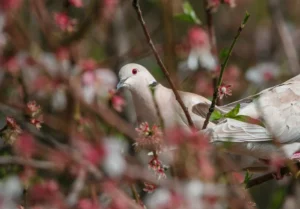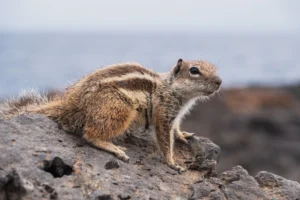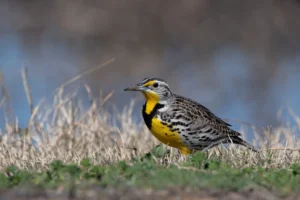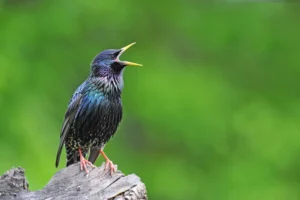Did you know about the mind-blowing birds live’s in the Morro del Jable region in southern Spain?
Jable is quite a fascinating spot for any nature lovers.
It is house to a variety of unique bird species.
This area on the island of “Fuerteventura” has a scenic coastline and mountain range that provides diverse habitats for many birds.
Morro del Jable is the area where you can spot a magnificent bird in its native habitat.
[su_quote]In this article, we have discovered for you some of the most notable birds in Morro del Jable, including:[/su_quote]
| TOP 10 UNIQUE BIRDS IN JABLE
Here are the top 10 marvelous birds you can find in Morro:
| BERTHELOT’S PIPIT

The Berthelot’s Pipit is a small passerine bird found across the Canary Islands, Madeira, and parts of North Africa.
It frequents open habitats like grasslands, scrub, and rocky areas.
A dull-colored pipit with pale underparts and brown upperparts, it blends into its surroundings.
It has a distinctive habit of repetitively raising and lowering its tail as it walks.
The Berthelot’s Pipit feeds on insects and seeds, which it finds walking along the ground.
It is often seen pairs or in alone and nests in a cup nest on the ground, laying 3-5 eggs.
| CATTLE EGRET

The Cattle Egret is a white heron that lives throughout the warm parts of the world.
It is often found in open habitats, agricultural fields, or pastures, where it feeds on insects and small vertebrates disturbed by large grazing animals.
The Cattle Egret gets its name from its habit of foraging alongside cattle, preying on insects flushed by their movements.
In the breeding season, Cattle Egrets develop colorful plumage and breed in colonies in trees, bushes, or reed beds, laying 2-5 eggs in a nest.
An opportunistic and adaptable bird, same as boat-tailed grackle the Cattle Egret has really expanded its range dramatically over the last century.
| ROCK DOVE

The familiar Rock Dove is found in cities and towns worldwide. It nests on buildings and forages for food leftovers in urban areas.
The common pigeon is well adapted to human settlements. Did you know about the reasons why the white dove is the symbol of peace and purity?
With gray and white plumage, reddish feet, and a stocky build, the Rock Dove is ubiquitous in urban parks and city centers.
| COLLARED DOVE

The Collared Dove is a slender, fast-flying dove common across Europe and Asia.
It has pale brown plumage with black-and-white markings on its neck. Collared Doves forage for grains, seeds, and scraps in open country.
They build a loose stick nest in trees or bushes and lay two white eggs.
Collared Doves are familiar visitors to gardens and farmyards because of their cooing call and grey-buff coloration,
| YELLOW-LEGGED GULL

The Yellow-legged Gull is a large gull found around the Mediterranean, Atlantic coasts of Europe, and into the Baltic and Red Seas.
As its name suggests, it has bright yellow legs and a heavy yellow bill.
It breeds in noisy colonies on coasts and islands, nesting on the ground or cliff ledges.
The Yellow-legged Gull feeds at sea or in harbors, scavenging fish, garbage, and scraps.
| GRELAG GOOSE

The Greylag Goose is a bulky, orange-billed goose that breeds across northern Europe and Asia.
It has gray plumage with a white rump and black legs and feet.
Greylag Geese feed on grasses, sedges, and grains, grazing in open country.
They nest near freshwater, building a cup nest and laying 3-5 eggs.
Greylag Geese often fly in V-shaped formations or gather on lakes and marshes.
| BARBARY GROUND SQUIRREL

The Barbary Ground Squirrel inhabits rocky areas and scrubland of North Africa.
It is buff-colored with a bushy tail and light speckling. Barbary Ground Squirrels live in caves in colonies, feeding on plants, roots, seeds, and nuts.
They are most active during the day, foraging and sunbathing at the entrances to their burrows.
| COMMON KESTREL

The Common Kestrel is a small falcon in Europe, Asia, and Africa.
It prefers open country, steppes, and scrubland. Feeding on insects and small mammals, it hovers or perches and dives onto prey.
The Common Kestrel has reddish-brown upper parts, pale underparts, and black markings.
It nests in holes or crevices of buildings, cliffs, or trees, laying 3-6 eggs.
The kestrel is often seen hovering beside motorways, its pointed wings and long tail distinctive.
| WESTERN BLACKBIRD

The Western Blackbird is a common European passerine bird with black plumage and a yellow or orange beak.
The male blackbird is glossy black with a bright yellow beak, while the female is dark brown.
Western Blackbirds inhabit woods, parks, and gardens, feeding on insects, worms, and berries.
Their melodious song, with distinctive chuckling sounds, is a familiar sound in spring.
They build an untidy cup nest and lay 3-5 eggs.
| COMMON STARLING

The Common Starling is a stocky, short-tailed bird across Europe, Asia, and Africa.
Its plumage is iridescent purple-green and speckled in winter, turning darker in summer.
Starlings are highly social, foraging and roosting in large groups.
They frequent woodlands, farmland, and urban areas, feeding on insects, grains, and scraps.
Starlings build an untidy nest in cavities and lay 4-6 eggs.
Starlings Known for their vocal mimicry and murmurations, starling flocks can perform dramatic aerial displays.
| ARE THESE THE ONLY BIRDS?
These are not the only birds that live in Jable.
There are plenty of other birds to spot, including the Cream-colored Courser, Trumpeter Finch, Lesser Short-toed Lark, and the aptly named Desert Sparrow.
The mixture of woodland, savannah, and sea cliffs around Morro del Jable attracts various migrating birds, particularly raptors such as the Short-toed Snake Eagle and Bonelli’s Eagle.
| CONCLUSION
Due to Jable’s scenic and diverse landscape, Morro del Jable is a prime location for observing native birds in Fuerteventura.
Especially species adapted to hot climes and arid environments.
[su_quote].Over 100 species of birds recorded in the jable, making it a top destination for bird watching in the Canary Islands[/su_quote]
We hope you got enjoyed reading this!
[su_box title=”Suggested” style=”noise” title_color=”#fec201″]HERE ARE OUR OTHER MASTERPIECES![/su_box]
